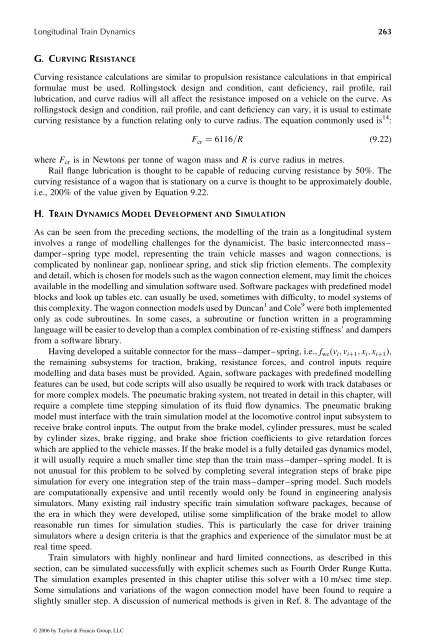Hi-Res PDF - CRCnetBASE
Hi-Res PDF - CRCnetBASE
Hi-Res PDF - CRCnetBASE
You also want an ePaper? Increase the reach of your titles
YUMPU automatically turns print PDFs into web optimized ePapers that Google loves.
Longitudinal Train Dynamics 263<br />
G . C URVING R ESISTANCE<br />
Curving resistance calculations are similar to propulsion resistance calculations in that empirical<br />
formulae must be used. Rollingstock design and condition, cant deficiency, rail profile, rail<br />
lubrication, and curve radius will all affect the resistance imposed onavehicle on the curve. As<br />
rollingstock design and condition, rail profile, and cant deficiency can vary, it is usual to estimate<br />
curving resistance by afunction relating only to curve radius. The equation commonly used is 14 :<br />
F cr ¼ 6116= R ð 9 : 22Þ<br />
where F cr is in Newtons per tonne of wagon mass and R is curve radius in metres.<br />
Rail flange lubrication is thought to be capable of reducing curving resistance by50%. The<br />
curving resistance ofawagon that is stationary on acurve is thought to be approximately double,<br />
i.e., 200% of the value given byEquation 9.22.<br />
H . T RAIN D YNAMICS M ODEL D EVELOPMENT AND S IMULATION<br />
As can be seen from the preceding sections, the modelling of the train as alongitudinal system<br />
involves arange of modelling challenges for the dynamicist. The basic interconnected mass–<br />
damper–spring type model, representing the train vehicle masses and wagon connections, is<br />
complicated by nonlinear gap, nonlinear spring, and stick slip friction elements. The complexity<br />
and detail, which is chosenfor models such as the wagon connection element, may limit the choices<br />
available in the modelling and simulation software used. Software packages with predefined model<br />
blocks and look up tables etc. can usually be used, sometimes with difficulty, to model systems of<br />
this complexity. Thewagon connection models used by Duncan 1 and Cole 9 were both implemented<br />
only as code subroutines. In some cases, asubroutine or function written in aprogramming<br />
language will be easier to develop than acomplex combination of re-existing stiffness’ and dampers<br />
from asoftware library.<br />
Having developed asuitable connector for the mass–damper–spring, i.e., f wcð v i ; v i þ 1 ; x i ; x i þ 1 Þ ;<br />
the remaining subsystems for traction, braking, resistance forces, and control inputs require<br />
modelling and data bases must be provided. Again, software packages with predefined modelling<br />
features can be used, but code scripts will also usually be required towork with track databases or<br />
for more complex models. The pneumatic braking system, not treated in detail in this chapter, will<br />
require acomplete time stepping simulation of its fluid flow dynamics. The pneumatic braking<br />
model must interface with the train simulation model at the locomotive control input subsystem to<br />
receive brake control inputs. The output from the brake model, cylinder pressures, must bescaled<br />
by cylinder sizes, brake rigging, and brake shoe friction coefficients to give retardation forces<br />
which are applied to the vehicle masses.Ifthe brake model is afully detailed gas dynamics model,<br />
it will usually require amuch smaller time step than the train mass–damper–spring model. It is<br />
not unusual for this problem to be solved by completing several integration steps of brake pipe<br />
simulation for every one integration step ofthe train mass–damper–spring model. Such models<br />
are computationally expensive and until recently would only be found in engineering analysis<br />
simulators. Many existing rail industry specific train simulation software packages, because of<br />
the era in which they were developed, utilise some simplification of the brake model to allow<br />
reasonable run times for simulation studies. This is particularly the case for driver training<br />
simulators where adesign criteria is that the graphics and experience of the simulator must be at<br />
real time speed.<br />
Train simulators with highly nonlinear and hard limited connections, as described in this<br />
section, can be simulated successfully with explicit schemes such as Fourth Order Runge Kutta.<br />
The simulation examples presented in this chapter utilise this solver with a10m/sec time step.<br />
Some simulations and variations of the wagon connection model have been found to require a<br />
slightly smaller step. Adiscussion of numerical methods is given in Ref. 8. The advantage of the<br />
© 2006 by Taylor & Francis Group, LLC









